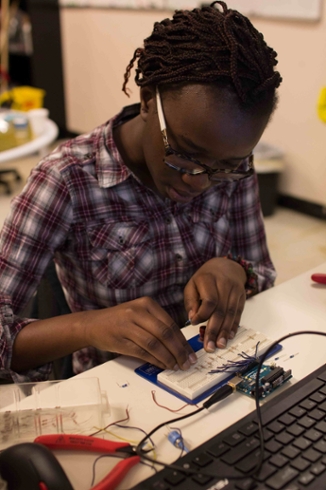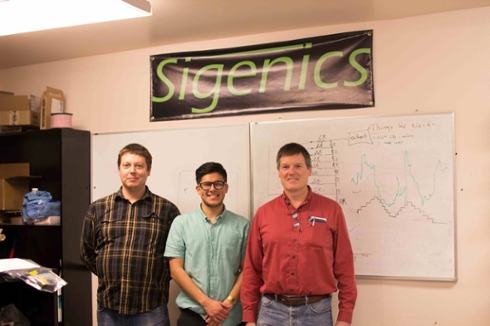Tags
"circuit design"
Sigenics, Reed Winter Externship Program, Debra Moda Raduma

Debra Moda Raduma, sophomore math major, participated in a winter externship in Southern California working with Reed parent Dr. Douglas Kerns at Sigenics, a circuit design and production company
Over winter break, I was fortunate enough to get to visit Southern California where I spent a few days, enjoying the good weather and scenery. I fell in love with Orange County right from the moment I landed at John Wayne Airport. I was so scared and excited at the same time but I had two other externs, Edgar ’17 and Farhan ’18, to share in my worries, as none of us knew what to expect. We were going to work at Sigenics, a company that specializes in the designing of microchips. It has two branches, one in Chicago and another in Sierra Madre, where we were scheduled to work.
The first day in the lab we were greeted by the photo of the famous mathematical physicist James Clerk Maxwell, whose frame hung steadily on one of the walls of the lab. I was already impressed from the word “go”. I was able to learn and understand how analogue and digital systems intersect. We worked on semi-projects, where we used breadboards to build circuits, and an arduino (I didn’t know what this was either!
Continue reading Sigenics, Reed Winter Externship Program, Debra Moda Raduma
Insights at Sigenics, Winter Externship, Edgar Perez

This winter, two fellow Reedies and I had an amazing experience working with Dr. Doulas Kerns and Mr. Marcus Snyder at Sigenics. Together, they provided an empowering three day externship and enlightening insights as to the life of electrical engineers. We started our trip with an hour long commute from the California coast to the base of Mt. San Antonio. Relieved from traffic by the carpool lane and good music, our trip to Sigenics was always pleasurable.
We spent our first day learning about the company and the different roles of scientists and engineers. Dr. Kerns started off with a small tour of their lab and showed us some of their designs. He really blew us away when he showed us the incredibly small size of their circuit designs and their circuit elements. A chip no bigger than 1 squared millimeter can house billions of transistors. As if hearing about this wasn’t enough, Dr. Kerns pulled out a sample of their work and placed it under and a powerful microscope. There is was. Mind-numbing in scale and constructed with jaw-dropping precision. Millions of components carefully embedded in a tiny silicon chip, and the chip: even more precisely designed. Yet here we were, three unexperienced undergrads sharing a room with the chip designers themselves!
The relationship between an engineer and a scientist was the next item on Dr. Kern’s agenda. Using a very Reed-esque analogy of a pizza shop, he demystified some of the quirks of engineering. The relationship between engineers and scientists is actually more symbiotic in nature than one would expect, he explained. Engineers use scientific results to develop tools for scientists. In turn, scientists use the tools to develop new results. This is relationship is a vertical growth pattern where the two fields help propel one another. Along the way, the tools and results produced by both parties will spread horizontally, manifesting themselves as new technologies or constructions for the benefit of our societies. We ended the day with a scientific investigation of the phenomena occurring “behind the scenes” in the electrical components we used the following day, and (appropriately) some delicious pizza from a local shop.
Continue reading Insights at Sigenics, Winter Externship, Edgar Perez
